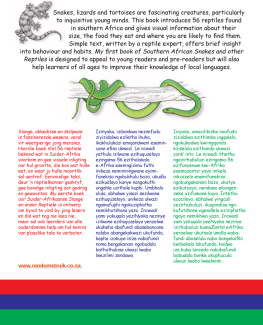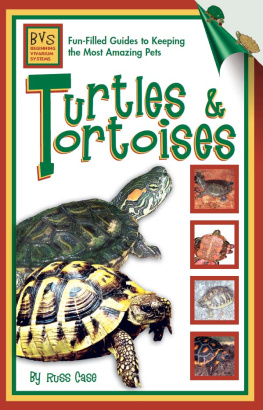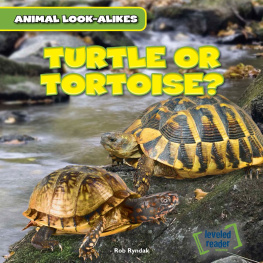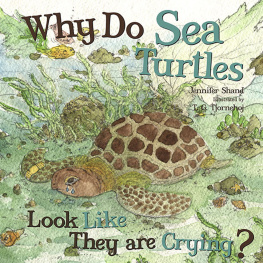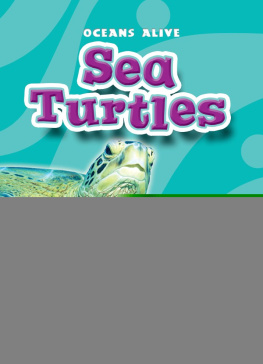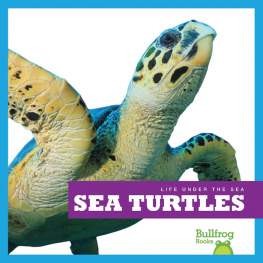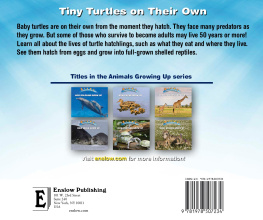Bill Branch - Tortoises, Terrapins & Turtles of Africa
Here you can read online Bill Branch - Tortoises, Terrapins & Turtles of Africa full text of the book (entire story) in english for free. Download pdf and epub, get meaning, cover and reviews about this ebook. year: 2012, publisher: Struik Nature (Random House Struik), genre: Home and family. Description of the work, (preface) as well as reviews are available. Best literature library LitArk.com created for fans of good reading and offers a wide selection of genres:
Romance novel
Science fiction
Adventure
Detective
Science
History
Home and family
Prose
Art
Politics
Computer
Non-fiction
Religion
Business
Children
Humor
Choose a favorite category and find really read worthwhile books. Enjoy immersion in the world of imagination, feel the emotions of the characters or learn something new for yourself, make an fascinating discovery.
- Book:Tortoises, Terrapins & Turtles of Africa
- Author:
- Publisher:Struik Nature (Random House Struik)
- Genre:
- Year:2012
- Rating:4 / 5
- Favourites:Add to favourites
- Your mark:
- 80
- 1
- 2
- 3
- 4
- 5
Tortoises, Terrapins & Turtles of Africa: summary, description and annotation
We offer to read an annotation, description, summary or preface (depends on what the author of the book "Tortoises, Terrapins & Turtles of Africa" wrote himself). If you haven't found the necessary information about the book — write in the comments, we will try to find it.
Tortoises, Terrapins & Turtles of Africa — read online for free the complete book (whole text) full work
Below is the text of the book, divided by pages. System saving the place of the last page read, allows you to conveniently read the book "Tortoises, Terrapins & Turtles of Africa" online for free, without having to search again every time where you left off. Put a bookmark, and you can go to the page where you finished reading at any time.
Font size:
Interval:
Bookmark:
Terrapins & Turtles
of Africa

Bill Branch
Struik Nature
(an imprint of Random House Struik (Pty) Ltd)
Reg. No. 1966/003153/07
Wembley Square, First Floor, Solan Street, Cape Town, 8001
PO Box 1144, Cape Town, 8000 South Africa
Visit us at www.randomstruik.co.za
and subscribe to our newsletter for monthly updates and news
First published in 2008
This eBook edition 2012
Copyright in published edition, 2008: Random House Struik (Pty) Ltd
Copyright in text, 2008: Bill Branch
Copyright in photographs, 2008: Bill Branch, with the exception of the following:
Graham Alexander: pp 27 (b), 55 (r), 60 (tr); Roger Bour: pp 94 (tl), 98 (r), 104 (tr); Marius Burger: pp 67, 13, 15, 21, 29, 37 (l & c), 39, 40 (tl & r), 42 (bl), 54 (tr, cr, bl), 56 (r), 60 (br), 64 (tl), 67 (b), 68 (t), 72 (b), 87 (tl & r), 95 (t); Bernard Devaux: pp 86 (l); A. de Villiers: p 27 (t); Fausto: pp 51, 99 (t); Dieter Gramentz: pp 75 (br), 77 (tr, cr); G. Hughes: pp 112 (t), 118; IOA/Peter Blackwell: p 105 (t); Krystal Tolley: p 102 (b); DW Lawson: p 95 (b); Victor Loehr: pp 42 (r), 60 (l); Johan Marais: p 64 (b); Jerome Maran: pp 75 (tr), 93 (t), 96 (l), 98 (l), 104 (br); Thomas Mazuch: p 88; Colin McRae: p 9 (b); J. Measey: p 58 (b); Olivier Pauwels: pp 26, 75 (tl), 77 (b), 122, 123; Mark Oliver Roedel: pp 19; M. Smale: pp 18, 116; Colin Tilbury: pp 55 (l), 105 (b); P. van der Shouw: pp 89 (t, b), 93 (c); P. van Putten: p 90 (l).
Key: t = top, b = bottom; l = left; r = right; c = centre.
Photograph of the author courtesy of Bernard Devaux
Publishing manager: Pippa Parker
Managing editor: Helen de Villiers
Editor: Leonie Hofmeyr-Juritz
Project co-ordinator: Gill Gordon
Design Director: Janice Evans
Designer: Louise Topping
Proofreader: Glynne Newlands
Cartographer: Neil Bester
All rights reserved. No part of this publication may be reproduced, stored in a retrieval system, or transmitted, in any form or by any means, electronic, mechanical, photocopying, recording or otherwise, without the prior written permission of the copyright owner(s).
ISBN 978 1 77007 463 7 (Print)
ISBN 978 1 92054 432 4 (ePub)
ISBN 978 1 92054 433 1 (PDF)
: Loggerhead Sea Turtle.

Leopard Tortoise in the Swartkop River, Namibia.
Although southern Africa is a biodiversity hotspot and South Africa is home to the worlds richest diversity of tortoises, there have been relatively few popular books that introduce the lives of these fascinating reptiles to the interested naturalist. Terrapins are much more diverse in tropical Africa, where they swim in the major rivers, rift lakes, marshes and swamps. Sea turtles glide gracefully throughout Africas coastal waters, but continue to nest on only a few sheltered and protected beaches. Africas reptile wealth deserves to be better known, and this small volume takes a step in that direction.
The coverage of this book is restricted to sub-Saharan Africa and its coastal islands. The relatively few species on the Indian Ocean islands have been excluded, as the taxonomy of some of these forms is unresolved, whilst others have been relatively recently introduced. Similarly, the small radiation of tortoises and terrapins along the coastal regions of North Africa has not been covered. There is much scientific debate about just how many species are found in these two regions. Moreover, those in North Africa represent a relatively recent radiation, and are more closely related to Eurasian species. Kemps Ridley Sea Turtle is mainly restricted to the western Atlantic, with only a few vagrant specimens known from the Atlantic off North Africa. It is not known to breed on African beaches, or to undergo feeding migrations to African waters, and so is also excluded from this book.
With these limitations, the 46 species of chelonians found in sub-Saharan Africa are covered; together they represent nearly 15 per cent of the worlds chelonians. This field guide describes how to identify these species, where they are likely to be found, and summarises their lives in simple terms to help the interested naturalist.
BILL BRANCH
All field guides build on previous observations and research accumulated by many people. This book compiles this body of knowledge; a small fraction of the related synthetic material is summarised in Resources (). Only within the last 25 years have detailed studies on the ecology of the chelonians in Africa begun. Significant recent work in southern Africa has been undertaken at the University of the Western Cape by Reitha Hofmeyr and her students and colleagues, particularly Victor Loehr and Brian Heenan. Elsewhere in Africa, the studies of Luca Luselli, Adrian Hailey and Jonathan Kabigumila have increased our knowledge of the lives of other species. Dieter Gramentz has undertaken a series of studies of the ecology of African soft-shelled terrapins, Trionycidae, culminating in two definitive monographs. The detailed taxonomic studies of Roger Bour (Museum National dHistorie Naturelle, Paris) continue to reveal new species of African chelonians, with the discovery of two new species of Hinged terrapin in the last five years. Field work in Africa is often difficult and dangerous, but this does not deter colleagues such as Marius Burger, Luca Luselli, Jerome Maran, Thomas Mazuch, Olivier Pauwels or Colin Tilbury. Bernard Devaux and his colleagues at SOPTOM, France, have sparked public interest in chelonians worldwide, and have also been instrumental in protecting endangered tortoises in Senegal and Madagascar with their innovative Tortoise Villages.
The species maps derive from numerous sources: my own, and those of the database of the South African Reptile Atlas, for southern African species; those for side-necked terrapins from the studies of Don Broadley and Roger Bour; and the general and regional maps of African chelonians for a variety of other species, by John Iverson, Bernard Devaux and Carl Ernst. I also thank George Hughes who read and gently corrected the section on sea turtles.
A number of colleagues assisted with photographs of rare or restricted species, or allowed me to replace my slides with their more artistic studies. For these I thank Graham Alexander, Roger Bour, Bernard Devaux, Jacques Fretey, Dieter Gramentz, George Hughes, Victor Loehr, Colin McRae, Johan Marais, Jerome Maran, Thomas Mazuch, John Measey, Olivier Pauwels, Mark-Oliver Roedel and Colin Tilbury. A special thanks to Marius Burger, whose tortoise photography is just too good; if he could only look after his camera lenses as well as his hair...
Finally, Pippa Parker, publisher for the Natural History section at Struik, continues to show faith in my abilities and, with her editorial and design teams, led by Helen de Villiers and Janice Evans respectively, produces stunning books that are a credit to any author; the phrase silk purses from pigs ears comes to mind! For this book, special thanks are due to the designer, Louise Topping, and editor, Leonie Hofmeyr-Juritz.

Font size:
Interval:
Bookmark:
Similar books «Tortoises, Terrapins & Turtles of Africa»
Look at similar books to Tortoises, Terrapins & Turtles of Africa. We have selected literature similar in name and meaning in the hope of providing readers with more options to find new, interesting, not yet read works.
Discussion, reviews of the book Tortoises, Terrapins & Turtles of Africa and just readers' own opinions. Leave your comments, write what you think about the work, its meaning or the main characters. Specify what exactly you liked and what you didn't like, and why you think so.


